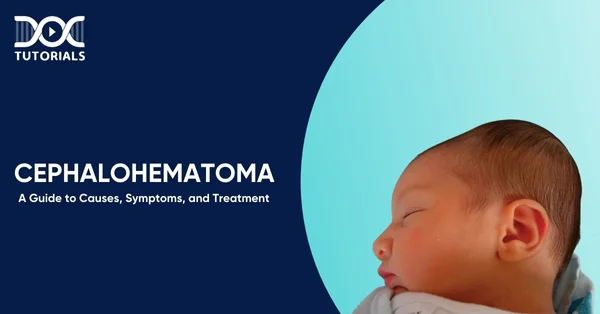Cephalohematoma | A Guide to Causes, Symptoms, and Treatment

Cephalohematoma is a condition found in newborn babies if the mother has had a difficult delivery through the vagina. It is a harmless condition in which blood pools under the baby’s scalp. In most cases, it is cured on its own and does not require any treatment. However, in certain cases, complications may develop, such as infections, jaundice, anaemia, etc.
Read on to learn more about this condition, its cause, risk factors, and treatment methods.
What is Cephalohematoma?
When blood gets collected between the skull and scalp of a newborn baby, it is called cephalohematoma. The term “cephalo” means head, and “hematoma” refers to a blood clot outside the blood vessels.
When the scalp’s blood vessels are ruptured due to pressure on a newborn’s scalp, it leads to birth injuries like cephalohematoma. The blood clots under the scalp, forming a soft swelling that can get hard eventually.
What are the Causes of Cephalohematoma?
Cephalohematoma or scalp hematoma may occur for unavoidable reasons or, at times, due to medical malpractice. Here are the major causes:
- Assisted-Delivery Device Complications
Vacuum extractors, forceps, and other assisted-delivery devices can put excessive pressure on the newborn baby’s head and lead to complications like cephalohematoma. If these devices are not used effectively, they can cause cephalohematoma in newborns.
- Position of the Baby
If the baby’s head is not in the down position but facing back, it may take longer for the doctors to deliver the baby. In such cases, doctors use assisted-delivery devices to make the delivery process smooth, which may lead to cephalohematoma.
If the baby’s head is positioned in such a way that it can push the mother’s pelvic bone during delivery, it can cause cephalohematoma. In such cases, the blood vessels on the baby’s scalp get ruptured, leading to a bump on the head.
- Medical Negligence
Sometimes, doctors or other professionals commit some avoidable mistakes due to negligence. This can lead to birth injuries like cephalohematoma or others.
- Size of the Baby
If the baby is larger than average (foetal macrosomia) and weighs more than 8 pounds 13 ounces, they are more likely to push against the mother’s pelvis, leading to cephalohematoma.
What are the Risk Factors of Cephalohematoma?
Here are some of the risk factors that can lead to cephalohematoma:
- Epidural pain relief while giving birth to a child
- If the mother is carrying twins or triplets, i.e. multiple babies
- Difficult and prolonged vaginal delivery
What are the Symptoms of Cephalohematoma?
Depending on the severity of the condition, the symptoms of cephalohematoma may vary. Here are some of the common symptoms to look for:
- Swelling on the head
- Difficulty in feeding
- Large head size
- Fatigue
- Crying in a high-pitched voice
- Seizures
- Vomiting
- Bulging fontanel
In some children, the signs of cephalohematoma are immediately visible after birth. However, some may develop the symptoms after a few days or weeks.
How to Diagnose Cephalohematoma?
When a newborn shows signs of cephalohematoma, doctors begin by closely monitoring the baby’s head size to check for abnormal growth, which could indicate worsening bleeding or swelling. They use a measuring tape to track any changes.
Some of the diagnostic tests performed in this regard are:
- Blood Tests
In addition to physical exams, doctors will check the baby’s haematocrit level. It is a blood test that measures the proportion of red blood cells in the blood. A lower-than-normal haematocrit can signal blood loss due to the haematoma.
- Imaging Test
To better understand the situation, doctors often order imaging tests. A computed tomography (CT) scan is commonly used, but X-rays or magnetic resonance imaging (MRI) scans may also be recommended. These imaging studies help determine the exact location and size of the blood collection and whether there are any complications that need urgent attention.
An early and thorough diagnosis is essential to manage cephalohematoma and prevent possible long-term effects.
What are the Treatment Options for Cephalohematoma?
After a diagnosis, the doctor will suggest cephalohematoma treatment depending on the severity of the condition. In most mild cases, no special treatment is needed, as these usually resolve naturally with rest over time.
However, if the haematoma is more severe, surgical intervention might be necessary. Surgery could involve removing blood clots, repairing damaged blood vessels, or draining accumulated blood caused by injury.
Prompt and appropriate treatment helps prevent complications that could impact a child’s growth and development. Fortunately, with the right care, most infants recover completely and do not experience lasting effects from cephalohematoma.
What is the Difference Between Cephalohematoma and Caput Succedaneum?
Cephalohematoma and caput succedaneum can occur independently or concurrently. Therefore, neither of these requires any therapy for treatment.
Caput succedaneum, also known as newborn conehead, is a swelling or oedema on top of the newborn baby. It appears during birth like an enlarged, spongy bump on the head and crosses the suture lines.
On the other hand, cephalohematoma is a haemorrhage (blood clot) under the scalp of a newborn. It also appears immediately after the birth, but the bump does not go beyond the joining lines of the child’s head bones.
FAQs About Cephalohematoma
- How can cephalohematoma affect a newborn baby?
During childbirth, pressure on a newborn’s scalp can break small blood vessels, causing blood to pool and form a soft bump, usually at the back of the head. This bump may harden and develop a ring-like shape as it heals.
- What are the complications associated with cephalohematoma?
Cephalohematoma can cause complications like anaemia from blood loss, calcifications affecting skull growth, infections, including serious bone infections, jaundice due to increased bilirubin, and sometimes linear skull fractures that heal naturally.
- How to manage cephalohematoma?
Managing cephalohematoma involves regular monitoring, treating issues like jaundice or anaemia if they arise, and preventing infection by avoiding irritation. Most cases heal naturally with proper medical follow-up.
- What are the different types of cephalohematoma?
Doctors classify newborn cephalohematomas by when symptoms appear. Acute cases show signs right after birth, while chronic cases develop days or weeks later. Untreated acute cases can become chronic.
Conclusion
Cephalohematoma is mostly a harmless birth injury. However, if the child gets a chronic cephalohematoma, immediate treatment is required. It is important to have the right knowledge of this birth condition to ensure the safety of a newborn.
Moreover, if you are a medical student preparing for NEET PG exams, cephalohematoma is a crucial topic to cover. Rely on DocTutorials for concise video lectures, live sessions, faculty-reviewed question banks, mock tests, and more to take your exam preparation to the next level. Enrol in our NEET PG courses now!
Latest Blogs
-

NEET SS Exam 2024: Analysis, Key Dates, Counselling
The NEET SS 2024 exam kicked off on March 29, 2025. Over two days and two slots, candidates across 13…
-

NEET PG Registration 2025: An Essential Guide For Exam Prep
The NEET PG registration, which is conducted online, is a crucial step in the exam process. Filling out the NEET…
-

NEET PG Syllabus 2026: A Must-Have Complete Guide for Exam Success
The NEET PG Syllabus acts as one of the foundation stones for aspiring postgraduate medical students like you who are…




